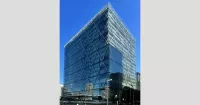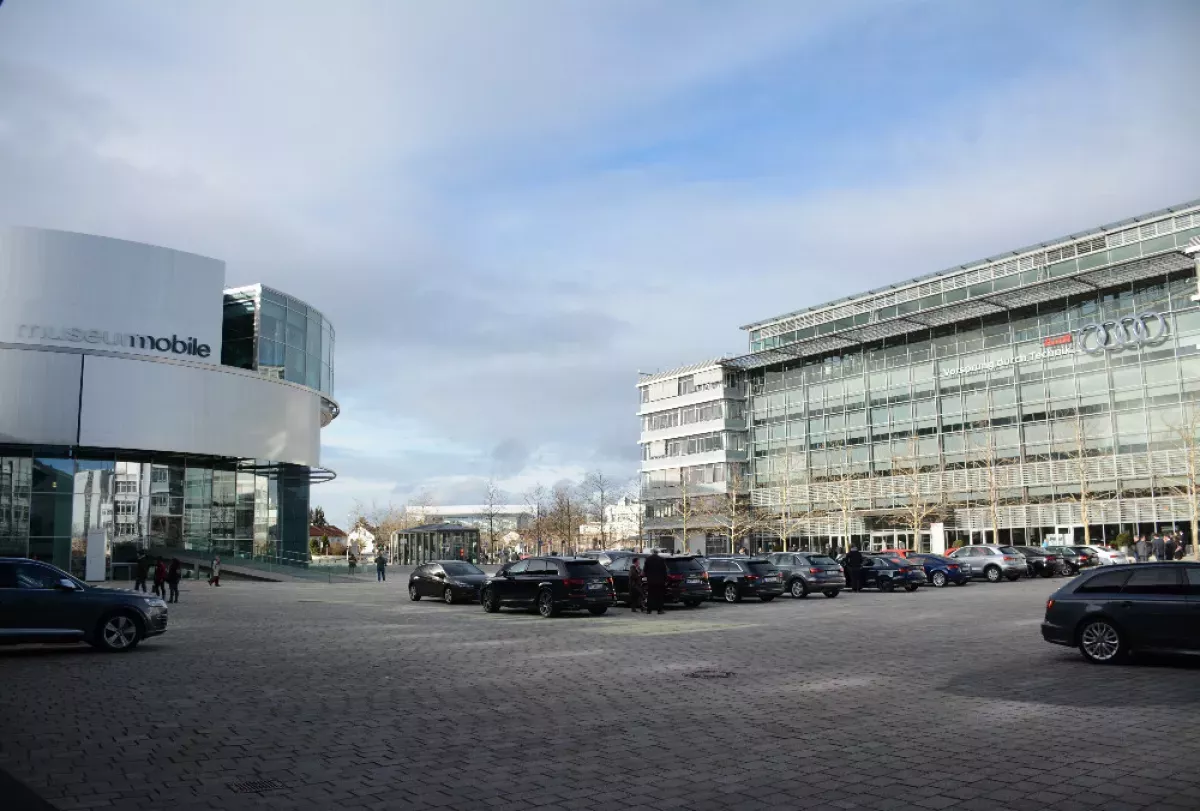Audi AG, headquartered in Ingolstadt, Bavaria, Germany, is a German luxury vehicle manufacturer. As a subsidiary of the Volkswagen Group, Audi operates nine production plants globally.
1902: Horch Moves Company
August Horch moved his company to Reichenbach im Vogtland in 1902.
May 1904: August Horch & Cie. Motorwagenwerke AG Founded
August Horch founded the August Horch & Cie. Motorwagenwerke AG, a joint-stock company, in Zwickau in May 1904.
July 1909: August Horch Founds Second Company
August Horch founded his second company, the August Horch Automobilwerke GmbH, after leaving his first company in July 1909.
April 1910: Audi Automobilwerke GmbH Founded
Audi Automobilwerke GmbH was entered in the company's register of Zwickau registration court in April 1910.
1915: Company Renamed Audiwerke AG Zwickau
Audi Automobilwerke GmbH was renamed to Audiwerke AG Zwickau in 1915.
1920: August Horch Leaves Audiwerke
August Horch left Audiwerke in 1920 to join the ministry of transport.
1920: Audi Script Designed by Lucian Bernhard
Lucian Bernhard, a renowned graphic designer, created the original "Audi" script with its distinctive slanted tails on the "A" and "d" in 1920. This script was designed for the original Audi company.
September 1921: First Left-Hand Drive German Car Released
Audi released the Audi Type K in September 1921, the first German production car with left-handed drive.
1924: First Six-Cylinder Model Released
The Audi Type M, the company's first six-cylinder model with a 4,655 cc engine, was released in 1924.
August 1928: DKW Acquires Majority Stake in Audiwerke
Jørgen Rasmussen, owner of Dampf-Kraft-Wagen (DKW), acquired the majority of shares in Audiwerke AG in August 1928.
1929: Audi Zwickau and Audi Dresden Models Launched
Audi launched the Audi Zwickau and Audi Dresden models in 1929, which used 8-cylinder engines from the American car manufacturer Rickenbacker.
1932: Auto Union is Formed
Audi merged with Horch, DKW, and Wanderer to form Auto Union AG, Chemnitz in 1932.
1932: Auto Union is Formed and Audi Front Released
Audi merged with Horch, DKW, and Wanderer to form Auto Union AG, Chemnitz in 1932. This year also saw the release of the Audi Front, the first European car to combine a six-cylinder engine with front-wheel drive.
1932: Richard Bruhn Becomes Chairman of Auto Union
Richard Bruhn, a Nazi party member, became the chairman of Auto Union in 1932.
1936: Auto Union Formed and Represented at the Olympics
In 1936, Auto Union was formed from a merger of four German automotive brands. The four ring emblem was designed to represent the four marques of the newly formed Auto Union: Audi, DKW, Horch, and Wanderer. The design was intended to evoke the Olympic logo as Berlin was the host city of the 1936 Summer Olympics.
1938: DKW Accounts for 17.9% of German Car Market
By 1938, DKW, part of Auto Union along with Audi, accounted for 17.9% of the German car market, while Audi only accounted for 0.1%.
1939: Audi Disappears From Car Market
After the last few cars were delivered in 1939, the Audi name disappeared from the car market for over two decades.
1945: Auto Union Begins Relocating to West Germany
Auto Union executives began moving the company to Ingolstadt, West Germany, in late 1945.
1945: World War II Ends
World War II ended in 1945, and Richard Bruhn once again became chairman of Auto Union after it was reestablished.
August 1948: Auto Union AG of Chemnitz Dissolved
Auto Union AG of Chemnitz was removed from the commercial register in August 1948, liquidating the company.
September 1949: New Auto Union Launched
A new Auto Union, headquartered in West Germany, was launched in Ingolstadt in September 1949.
1949: Former Audi Factory Restarts Production
The former Audi factory in Zwickau restarted production of pre-war models in 1949.
1949: Reformed Auto Union Established
The reformed Auto Union was established in Ingolstadt in 1949.
1951: Death of August Horch
August Horch, the founder of Audi, passed away in 1951.
1958: Daimler-Benz Acquires Majority Stake in Auto Union
In 1958, Daimler-Benz, under pressure from shareholder Friedrich Flick, acquired an 87% stake in Auto Union.
1959: Daimler-Benz Takes Full Ownership of Auto Union
Daimler-Benz increased its holding in Auto Union to 100% in 1959.
1964: Volkswagen Acquires Stake in Auto Union
Volkswagen obtained a 50% holding in Auto Union in 1964, acquiring the Ingolstadt factory, the DKW and Audi brands, and the rights to a new engine design.
September 1965: DKW F102 Transformed into the Audi
In September 1965, the DKW F102 was equipped with a four-stroke engine, received a facelift, and was rebranded as the "Audi". Volkswagen discontinued the DKW brand due to its association with two-stroke technology.
1965: Resurrection of the Audi Brand
After a 25-year hiatus, the "Audi" name was revived in 1965 following the sale of the Auto Union business.
1965: Audi Brand Relaunched
The Audi brand was relaunched by Volkswagen after they acquired Auto Union from Daimler-Benz in 1965.
1965: Volkswagen Revives the Audi Brand and Script
When Volkswagen revived the Audi brand in 1965, they brought back Lucian Bernhard's original script with the slanted tails. This marked a return to the brand's visual heritage.
1966: Volkswagen Assumes Full Control and Expands Production
Volkswagen gained complete control of Ingolstadt in 1966 and utilized the factory's capacity to produce an additional 60,000 Volkswagen Beetles annually.
1967: Champion Racing Makes History
Champion Racing became the first American team to win Le Mans since the Gulf Ford GTs in 1967, marking a significant achievement for the team.
1967: Launch of the NSU Ro 80
The innovative NSU Ro 80, with advanced features like aerodynamics and safety, was introduced in 1967.
1968: Audi 100 Launch
Following the successful launch of the Audi 100 in 1968, Audi continued its expansion.
1968: Audi 100: A Turning Point for the Brand
The Audi 100, developed in secret by Auto Union engineers, was launched in 1968 and achieved significant success, solidifying the Audi brand's revival.
January 1969: Formation of Audi NSU Auto Union AG
The merged company, Audi NSU Auto Union AG, was established on January 1, 1969, marking the reemergence of Audi as a distinct brand.
1969: Auto Union and NSU Merge
Auto Union and NSU, known for its motorcycles and small cars, merged in 1969.
1969: Volkswagen Merges Auto Union and NSU
Volkswagen merged Auto Union with NSU Motorenwerke in 1969, creating the modern Audi company as it is known today.
1970: Audi Enters the US Market and the K70 is Launched
Audi was introduced to the United States market in the 1970 model year. The same year, the NSU K70, intended as a mid-sized car, was launched as a Volkswagen instead.
1971: Audi Breaks Distance Record
The Audi R15 TDI Plus broke the distance record at Le Mans in 2010, a record previously held by the Porsche 917K of Martini Racing since 1971.
1972: Audi 80 Released
Audi released the Audi 80 in 1972, powered by the EA111 and EA827 inline-four engine families.
1972: Launch of the Audi 80
The first generation Audi 80, which would serve as a blueprint for Volkswagen's new front-wheel-drive water-cooled range, was introduced in 1972.
1973: NSU Prinz Models Discontinued
The NSU Prinz models were discontinued in 1973.
1974: Audi 50 Released
In 1974, Audi introduced the Audi 50. This model, along with the earlier Audi 80, played a crucial role in the resurgence of the parent company Volkswagen, with their engines powering various VW models like the Polo, Golf, Passat, and Scirocco.
1975: Audi Pioneers Galvanized Steel for Rust Prevention
Around 1975, Audi, following Porsche's lead, became the first mass-market car manufacturer to use fully galvanized steel bodies for its vehicles, significantly enhancing their rust resistance.
1976: Second Generation Audi 100 Production Moves to Neckarsulm
By 1976, the entire production of the second-generation Audi 100 (C2) had been shifted from Ingolstadt to the former NSU plant in Neckarsulm, which would become the production site for Audi's higher-end models.
1977: Audi Shifts Focus from Four Rings to Script
Following the closure of NSU in 1977, Audi shifted its logo emphasis from the four rings to the "Audi" script. The script was encased within a black (later red) ellipse and often appeared alongside the Volkswagen roundel, reflecting the brands' shared dealer network under V.A.G.
1977: End of the NSU Ro80 and Effective End of the NSU Brand
The production of the NSU Ro80, plagued by engine problems, ceased in 1977, marking the effective end of the NSU brand.
1978: Audi Implements Modifications After Recalls
In response to the recalls, Audi implemented various modifications to its vehicles. Early changes involved adjusting the pedal spacing on automatic models, while later repairs, affecting cars manufactured as far back as 1978, included a device requiring drivers to press the brake pedal before shifting from park.
1980: Audi Quattro Revolutionizes Rally Racing
The Audi Quattro, a four-wheel drive (4WD) turbocharged car, debuted in 1980 and quickly rose to prominence in the rally racing world.
1980: Debut of the Audi Quattro
The revolutionary "Audi Quattro," a turbocharged coupé and the first German mass-produced car with permanent all-wheel drive, was introduced in 1980. This model, often called the "Ur-Quattro," achieved considerable success in rally racing, associating the Audi name with technological advancements in the automotive industry.
1982: "Vorsprung durch Technik" Introduced to English-Speaking Audiences
Audi's German tagline, "Vorsprung durch Technik," meaning "Progress through Technology," was first used in English-language advertising after Sir John Hegarty of the Bartle Bogle Hegarty ad agency visited Audi's factory in 1982. Actor Geoffrey Palmer provided the voiceover for the phrase in the initial British television commercials.
1982: Audi 5000 Recall Investigations Begin
Beginning in 1982, Audi faced scrutiny in the U.S. as sales declined due to recalls of Audi 5000 models from 1982 to 1987. The recalls were prompted by reported incidents of sudden unintended acceleration, resulting in fatalities and accidents, leading to investigations by NHTSA.
1982: Audi Quattro Secures Manufacturers' Title in World Rally Championship
The Audi Quattro's dominance in rally racing continued, as it secured the manufacturers' title in the World Rally Championship in 1982, proving the effectiveness of its innovative four-wheel drive system.
1983: Hannu Mikkola Wins Drivers' Title in World Rally Championship with Audi Quattro
Hannu Mikkola, driving the Audi Quattro, won the drivers' title in the 1983 World Rally Championship, solidifying the car's reputation as a formidable competitor.
1984: Audi Introduces Short-Wheelbase Sport Quattro
Audi introduced the short-wheelbase Sport Quattro in 1984. This more agile version aimed to continue the Quattro's success in rally racing.
1984: Audi Quattro Continues Winning Streak in World Rally Championship
Stig Blomqvist, at the wheel of the Audi Quattro, clinched the drivers' title in the 1984 World Rally Championship. The Quattro also secured the manufacturers' title that year, marking a period of dominance for Audi in the sport.
1985: Peak Sales Before Decline
Audi reached a peak in U.S. sales in 1985, selling 74,061 vehicles.
1985: Michèle Mouton Sets New Record at Pikes Peak International Hill Climb with Audi Sport Quattro S1
In 1985, Michèle Mouton etched her name in motorsport history by setting a new record at the Pikes Peak International Hill Climb driving the Audi Sport Quattro S1. Her achievement marked a significant milestone for women in motorsport.
1985: Audi AG Becomes the Official Name
With the Auto Union and NSU brands effectively retired, the company was officially renamed Audi AG in 1985. The headquarters returned to Ingolstadt, and two subsidiaries, Auto Union GmbH and NSU GmbH, were established to manage the historical trademarks and intellectual property.
November 1986: 60 Minutes Report on Audi 5000
On November 23, 1986, the news program 60 Minutes aired a segment featuring interviews with individuals who claimed to have experienced sudden unintended acceleration in their Audi 5000 vehicles. However, it was later revealed that the program had staged the malfunction depicted in the report.
1986: Audi Withdraws from International Rallying; Bobby Unser Sets New Pikes Peak Record with Audi
Audi made a significant decision to withdraw from international rallying in 1986 following a tragic accident involving one of their cars. On a more positive note, Bobby Unser set a new record at the Pikes Peak International Hill Climb driving an Audi, showcasing the brand's continued pursuit of motorsport excellence.
1986: Introduction of the Audi 89
The Audi 89, a completely redesigned model, was launched in 1986 and enjoyed strong sales, replacing the aging Audi 80.
1987: Audi 5000 Recall Investigations Continue
Audi continued to grapple with the fallout of the recalls of Audi 5000 models, which began in 1982 and extended to 1987. The recalls, initiated due to reports of sudden unintended acceleration, prompted investigations by NHTSA and had a significant impact on Audi's sales in the U.S.
1987: Launch of the Audi 90
Audi introduced the new and stylish Audi 90 in 1987, offering a more comprehensive set of standard features.
1987: Audi 5000 Class Action Lawsuit Filed
In 1987, a class-action lawsuit was filed against Audi by approximately 7,500 owners of the Audi 5000 model, alleging issues with sudden unintended acceleration. This lawsuit remained unresolved for many years, highlighting the long-term legal ramifications of the recall crisis.
1987: Walter Röhrl Triumphs at Pikes Peak with Audi S1
Walter Röhrl, driving the powerful Audi S1, claimed victory at the 1987 Pikes Peak International Hill Climb, setting a new record in the process.
1988: Audi Enters Trans-Am Series in America
In 1988, Audi shifted its motorsport focus to circuit racing, entering the Trans-Am series in the United States.
1989: Audi Competes in IMSA GTO with Audi 90
Audi continued its foray into American motorsport in 1989, competing in the International Motor Sports Association (IMSA) GTO class with the Audi 90.
1989: Audi Renames Affected Models
In an attempt to recover from the damage caused by the recalls and negative publicity, Audi renamed its affected models in 1989. The 5000 was rebranded as the 100 and 200.
1989: Nissan's Infiniti Introduces "Q" Naming Scheme
Nissan's Infiniti brand first used the letter "Q" for their flagship car, the Infiniti Q45, in 1989. They later expanded this to their entire lineup.
1990: Audi V8 Released, Targeting a Higher Market Segment
In 1990, Audi released the Audi V8, a modified Audi 100/200 with a new engine and distinct bodywork, including a new grille integrated into the bonnet. This launch marked Audi's strategic move to compete with luxury automakers Mercedes-Benz and BMW.
1990: Audi Returns to European Motorsport, Enters DTM
Marking a return to European motorsport, Audi entered the Deutsche Tourenwagen Meisterschaft (DTM) series in 1990 with the Audi V8.
1990: Audi's Use of Inline-Five Cylinder Engines Declines
Prior to 1990, Audi championed the use of inline-five-cylinder engines, particularly the 2.1/2.2 L variant, as a durable alternative to the more common six-cylinder engines. These engines were featured both in their production cars and rally cars where they were tuned to deliver impressive power outputs.
1991: Sales Plummet After Recalls
Following a series of recalls related to sudden unintended acceleration allegations, Audi's sales in the U.S. plummeted to 12,283 units in 1991, a stark contrast to the 74,061 units sold in 1985.
1991: Audi's Lineup Expansion
In 1991, Audi offered a diverse lineup of vehicles, including the four-cylinder Audi 80, the five-cylinder Audi 90 and Audi 100, the turbocharged Audi 200, and the Audi V8. Additionally, a coupe version of the 80/90 was available with both four- and five-cylinder engine options.
1991: Volkswagen Group Acquires Zwickau Plant
The Volkswagen Group acquired the Zwickau plant after the reunification of Germany in 1991.
1991: Debut of the Audi S2 and S4
While the five-cylinder engine proved successful, Audi introduced a turbocharged 220 PS version in 1991. This engine, derived from the Sport Quattro, was fitted to the Audi Coupé (S2) and Audi 100 (S4), marking the beginning of the mass-produced S series performance cars.
1992: Introduction of the 2.8L V6 Engine
In 1992, Audi introduced a new 2.8L V6 engine with the launch of the all-new Audi 100. This engine was also incorporated into a facelifted Audi 80, providing customers with a choice of four-, five-, and six-cylinder engines across various body styles.
1993: Audi Shifts Focus to Super Touring Series
In 1993, Audi made a strategic decision to compete in the rapidly growing Super Touring series, which consisted of national championships around the world.
1994: Audi Launches A8 with Aluminum Space Frame Technology
In 1994, Audi launched the A8, the first mass-produced car to feature an all-aluminum frame known as the Audi Space Frame (ASF), resulting in significant weight savings and improved rigidity compared to traditional steel frames.
1994: Audi Oval Phased Out, Four Rings Return
In 1994, as Audi established its independent dealer network, the "Audi Oval" ellipse was phased out. The four rings regained prominence, signifying Audi's separation from the shared V.A.G. network. Simultaneously, Audi adopted the "Audi Sans" font, derived from Univers, for all its branding and marketing materials.
1995: Audi A4 Replaces the 80
In 1995, Audi introduced the A4 as the successor to the Audi 80, marking a significant shift in the company's model nomenclature.
1995: Audi vs. the International Olympic Committee
In 1995, the International Olympic Committee sued Audi in the International Trademark Court, claiming the four-ring emblem too closely resembled the Olympic rings. Audi ultimately lost the lawsuit.
1996: Audi A3 Hatchback Joins the Lineup
Audi expanded its model range in 1996 with the introduction of the A3 hatchback, a new model sharing its platform with the Volkswagen Golf Mk4.
1996: Audi Introduces Beating Heart Sound Trademark
Audi introduced a distinct beating heart sound as a trademark in 1996, adding an auditory dimension to its brand identity.
1997: Audi Sans Font Created
Ole Schäfer designed the "Audi Sans" font for MetaDesign in 1997. "Audi Sans" was based on Univers Extended and became a core element of Audi's visual identity.
1998: Engine Upgrades and Improvements
Audi introduced significant engine upgrades in 1998, replacing the existing V6 engines with new 2.4L and 2.8L 30V V6 units that offered notable improvements in power, torque, and overall smoothness.
1998: FIA Bans Four-Wheel Drive Cars from Super Touring Series; Audi Transitions to Sports Car Racing
The Fédération Internationale de l'Automobile (FIA) banned four-wheel drive cars from the Super Touring series in 1998. In response to this rule change, Audi transitioned its motorsport efforts to sports car racing.
1998: Debut of the Audi TT
The year 1998 saw the launch of the Audi TT, a distinctive coupe and roadster model that shared its underpinnings with the Audi A3.
1999: Audi Debuts at Le Mans
Audi began its journey in prototype sportscar racing with its debut at the 1999 Le Mans 24 hour, introducing two new car concepts: the open-cockpit R8R and the closed-cockpit R8C.
1999: Audi Introduces the A2
Audi launched the A2, a futuristic supermini based on the Al2 concept, in 1999. The car featured an aluminum space frame, a first in production car design, and aimed to regain consumer trust.
1999: Competitors Withdraw from Prototype Racing
Several major competitors, including BMW, Toyota, Mercedes, and Nissan, withdrew from prototype sportscar racing at the end of 1999.
1999: End of the Audi Cabriolet
The Audi Cabriolet, based on the Audi 80 platform, was discontinued in 1999 after a production run that saw it receive various engine upgrades throughout its lifespan.
2000: Audi Continues with R8R
Audi chose to develop the R8R concept further into the 2000 season due to favorable regulations for open-cockpit prototypes.
2000: Audi Recovers Sales Momentum
By the year 2000, Audi managed to regain its previous sales momentum in the U.S. market, reaching comparable levels to those achieved before the recall crisis.
2000: Audi Participates in SCCA Speed World GT Challenge with RS4
In 2000, Audi, through Champion Racing, participated in the SCCA Speed World GT Challenge with the RS4, competing against a diverse field of sports cars.
2000: Audi's Global Sales Growth Begins
The early 2000s marked the beginning of a period of significant global sales growth for Audi, with deliveries to customers reaching 653,000 units in 2000.
2000: Joest Racing Begins Le Mans Reign
The factory-backed Joest Racing team, using the Audi R8, began a streak of three consecutive victories at Le Mans in 2000.
2001: "Wackel-Elvis" Dashboard Figure Becomes a Hit
Audi's European television commercials in 2001, promoting the new multitronic continuously variable transmission, featured an Elvis Presley impersonator and a dashboard figure dubbed "Wackel-Elvis" ("Wobble Elvis" or "Wobbly Elvis"). The figure was initially intended for the commercials, but its popularity led to mass production in China and sales through Audi's factory outlet store.
2002: Audi R8 Dominates ALMS
Audi's R8s proved their dominance in the American Le Mans Series (ALMS) by achieving 25 victories between 2000 and the end of the 2002 season.
2002: Joest Racing Continues Winning Streak
Joest Racing, using the Audi R8, secured their third consecutive Le Mans victory in 2002, solidifying their dominance in the race.
2002: Abt Racing and Laurent Aïello Secure DTM Title with Audi TT-R
Privateer team Abt Racing, with driver Laurent Aïello, secured the 2002 DTM championship title using the Audi TT-R, showcasing the car's competitive spirit.
2002: Audi Brand Group Established
The Audi Brand Group was established in 2002, a subdivision within the Volkswagen Group's Automotive Division that brought together Audi, Lamborghini, and SEAT. The group's focus was on emphasizing sporty values and performance across these brands.
2003: Audi Supports Champion Racing
Audi began selling customer cars to Champion Racing in 2003, while also continuing to field its factory Audi Sport North America team.
2003: Audi Participates in 1000km of Le Mans
Audi took part in the 2003 1000km of Le Mans, a special one-off race designed to prepare teams for the upcoming European Le Mans Series in 2004.
2003: Champion Audi Wins SCCA Speed World GT Challenge with RS6
Champion Racing, representing Audi, emerged victorious in the 2003 SCCA Speed World GT Challenge with the RS6. The car's all-wheel drive system proved to be a significant advantage.
2003: Volkswagen Group Introduces Direct-Shift Gearbox (DSG)
In 2003, Volkswagen introduced the Direct-Shift Gearbox (DSG), a dual-clutch automatic transmission. Used in VW and Audi models, it offered a sportier driving experience than traditional automatic transmissions.
2003: Audi Introduces Multi Media Interface (MMI) in the A8
The 2003 Audi A8 debuted the Multi Media Interface (MMI), a centralized control system for infotainment, navigation, and vehicle functions. It featured a rotary knob and buttons for intuitive operation.
2003: Audi Brand Group Concludes
The Audi Brand Group, formed in 2002 as a subdivision within the Volkswagen Group, concluded its operations in 2003.
2003: Bentley and Audi Dominate Le Mans
Two Bentley Speed 8s, powered by Audi-designed engines and driven by Joest Racing drivers, finished first and second at the 2003 Le Mans. An Audi R8 finished third overall.
2004: Audi Returns to DTM with Factory-Backed A4s
After years of privateer involvement, Audi made a full-fledged return to the DTM series in 2004 with factory-supported A4 racing cars, signifying their renewed commitment to touring car racing.
2004: Audi Faces Challenges in SCCA Speed World GT Challenge
Audi faced stiff competition in the 2004 SCCA Speed World GT Challenge from the Cadillac CTS-V. Rule changes aimed at reducing the Audi's performance advantage hampered their title defense.
December 2005: Audi Unveils R10 TDI
Audi revealed its replacement for the R8, the R10 TDI, featuring a twin-turbocharged direct injection diesel engine, on December 13, 2005.
2005: Audi A2 Discontinued
Despite its innovative features, the Audi A2, launched in 1999, was discontinued in 2005 due to its high price and limited sales success. Audi decided not to immediately replace the model.
2005: Audi Pioneers White LED Daytime Running Lights
In 2005, Audi introduced white LED daytime running lights (DRLs) on the A8 W12, a first for a production car. This distinctive design element became a trademark of the Audi brand.
2005: Nissan Sues Audi Over "Q" Trademark
In 2005, Nissan North America filed a lawsuit against Audi regarding their use of the letter "Q" as a model name, as Nissan's Infiniti marque had been using it for their cars.
2006: Audi and Nissan Settle "Q" Trademark Dispute
Audi AG and Nissan reached a settlement over the "Q" trademark dispute in 2006. The agreement limited Audi to using the Q-prefix for only three models: the Q3, Q5, and Q7.
2006: Champion Racing Becomes Audi Sport North America
Champion Racing, after years of success as a private team running Audi R8s, replaced Team Joest as the official Audi Sport North America team from 2006 to 2008.
2006: R10 TDI Set to Replace R8
The Audi R10 TDI was slated to take over from the successful R8 in 2006, marking a new era for Audi in endurance racing.
2006: R10 TDI Debuts and Triumphs
The R10 TDI made its racing debut at the 2006 12 Hours of Sebring as a preparation for Le Mans, and went on to win both races, showcasing its diesel engine's potential.
2007: Audi Adopts "Truth in Engineering" Slogan in the US
Audi began using the slogan "Truth in Engineering" in its U.S. advertising campaigns in 2007. This slogan aimed to emphasize the brand's technological prowess and commitment to engineering excellence.
2008: Audi's Sales Double in Eight Years
Audi's global sales figures continued their upward trajectory, reaching an impressive 1,003,000 units in 2008, effectively doubling the 2000 sales figures in just eight years.
December 2009: Audi Launches Virtual Spaces in PlayStation Home
In December 2009, Audi became the first car manufacturer to create dedicated spaces within PlayStation Home, Sony's online community platform for the PlayStation 3. Audi launched two spaces: the Audi Home Terminal, offering video content, an internet browser, and a city view, and the Audi Vertical Run, a futuristic mini-game featuring the Audi e-tron concept.
2009: Audi Cup Inaugurated
Audi held the first edition of the Audi Cup in 2009, coinciding with the company's 100th anniversary. The Audi Cup is a pre-season football tournament that has become a notable event in the sport.
2009: Audi Type Font Introduced
Audi introduced a new corporate typeface called "Audi Type" in 2009. Designed by Paul van der Laan and Pieter van Rosmalen of Bold Monday, the font was commissioned from MetaDesign and started appearing in Audi's products and marketing efforts that year.
2009: Audi Reduces ALMS Involvement
Audi shifted its focus away from full American Le Mans Series Championships after 2009, choosing to participate primarily in the season-opening 12 Hours of Sebring as a test run for Le Mans.
2009: Audi e-tron Concept Debuted at Frankfurt Motor Show
Audi unveiled its first e-tron concept car at the 2009 Frankfurt Motor Show. Based on the R8 platform, the concept featured electric motors powering all four wheels and was slated for limited production.
2009: China Emerges as a Key Market
China emerged as a crucial market for Audi in 2009, accounting for 108,000 of the 705,000 vehicles delivered globally in the first three quarters of the year. The brand's popularity in China was partly attributed to its adoption as the preferred vehicle choice for government officials.
2009: Audi Logo Updated for Centennial Celebration
In 2009, Audi celebrated its centennial by updating its logo. The update, designed by Rayan Abdullah, involved changing the font to the left-aligned "Audi Type" and modifying the shading of the four overlapping rings.
2009: Audi Launches Audi Mileage Marathon to Promote Diesel Technology
In 2009, Audi launched the "Audi Mileage Marathon" to promote its diesel technology. This driving tour featured a fleet of 23 Audi TDI vehicles traversing the American continent from New York to Los Angeles, showcasing the fuel efficiency of Audi's diesel engines.
2009: Toyota Faces Similar Recall Challenges
The year 2009 saw Toyota facing widespread vehicle recalls, drawing comparisons to Audi's earlier experience with sudden unintended acceleration allegations and their impact on sales and reputation.
March 2010: Audi Showcases e-tron Electric Drive Powertrain System
By March 2010, Audi was developing its e-tron electric drive powertrain system and had showcased several concept cars with varying sizes and performance levels.
October 2010: Audi Sponsors Everton Football Club
Audi agreed to a three-year sponsorship deal with Everton Football Club in October 2010. This partnership expanded Audi's involvement in football sponsorship.
2010: BusinessWeek Article Highlights Unsettled Lawsuit
A BusinessWeek article in 2010 drew parallels between Audi's experience and the Toyota vehicle recalls of 2009-2010. The article highlighted an unsettled class-action lawsuit filed in 1987 by Audi 5000 owners, which remained in legal contention.
2010: R15 TDI Plus Sets New Record
Audi achieved a significant milestone in 2010 when the R15 TDI Plus set a new distance record at Le Mans.
2010: Audi Plans to Expand PlayStation Home Content
Audi announced plans to introduce further content to their PlayStation Home spaces in 2010. However, these plans were presumably abandoned after the platform's shutdown in 2015.
2010: Audi Updates Heartbeat Sound Logo
Audi updated its heartbeat sound logo in 2010. The new sound logo, developed by agencies KLANGERFINDER GmbH & Co KG and S12 GmbH, was first featured in an Audi A8 commercial with the tagline "The Art of Progress."
2010: BMW Introduces All-Wheel Drive in V8-Powered 7 Series
BMW introduced all-wheel drive in its V8-powered 7 Series for the first time in 2010, a feature that had been available in Audi's A8 since the 1990s.
2010: Audi Expands LED Technology to Headlights
In 2010, Audi further advanced its lighting technology by offering LED low- and high-beam headlights, enhancing visibility and efficiency.
May 2011: Audi Achieves Record Sales in America
Driven by strong sales of the new Audi A7 and Audi A3 TDI Clean Diesel models, Audi of America achieved record sales figures in May 2011.
2011: Audi's Multi Media Interface (MMI) Becomes Available Across Model Range
By 2011, Audi's Multi Media Interface (MMI) became available across its entire model lineup. The system, known for its user-friendliness, provided integrated control over various vehicle functions.
2011: BMW Offers All-Wheel Drive in V8-Powered 5 Series
Following the 7 series in 2010, BMW introduced all-wheel drive to its V8-powered 5 Series in 2011, while Audi had been offering this feature in its performance sedans for a longer time.
2011: Audi A8L W12 Debuts with Revised W12 Engine
The 2011 Audi A8L W12 marked a departure from the conventional V12 engines used by its competitors. It featured a revised 6.3-liter W12 (WR12) engine, known for its compact size and impressive 500 PS (370 kW; 490 hp) output. This design choice allowed Audi to incorporate all-wheel drive in its 12-cylinder sedan.
May 2012: Audi Sales Continue to Climb
Audi reported a 10% increase in sales in May 2012, with figures rising from 408 units to 480 units compared to the same period in the previous year.
September 2012: Audi Announces North American Plant
In September 2012, Audi made a significant announcement regarding its expansion in North America, revealing plans to construct its first manufacturing plant in the region. The facility, located in Puebla, Mexico, was slated to begin operations in 2016.
2012: Audi Wins Inaugural WEC
Audi emerged victorious in the first-ever FIA World Endurance Championship, securing the manufacturers' title after a successful season that included a win at the 24 Hours of Le Mans and a string of other victories.
2012: Sebring as Part of WEC
Audi's participation in the 12 Hours of Sebring in 2012 became part of the FIA World Endurance Championship season calendar, highlighting the race's significance in endurance racing.
2012: NHTSA Review of Audi Unintended Acceleration
In 2012, NHTSA published a review study summarizing its findings on the Audi unintended acceleration issue. The study concluded that while a failure in the idle-stabilizer system could cause an initial acceleration, pedal misapplication due to driver panic or unfamiliarity with the vehicle contributed to the severity of the incidents.
2012: Audi e-tron Displayed at Auto Expo 2012 in New Delhi
The Audi e-tron was showcased at the Auto Expo 2012 in New Delhi, India, starting on January 5th. This exhibition highlighted the e-tron's features, including its 1.4-liter engine and 54 km range on a single charge.
2013: Audi Achieves 100th Le Mans Prototype Win
Audi reached a historic milestone in 2013 by achieving their 100th victory in Le Mans prototypes at the Circuit of the Americas, solidifying their legacy as a dominant force in endurance racing.
2013: Audi e-tron Featured in "Iron Man 3"
The Audi e-tron made a notable appearance in the 2013 blockbuster film "Iron Man 3," driven by the film's protagonist, Tony Stark (Iron Man). This product placement further increased the car's visibility and appeal.
January 2014: Audi at the Consumer Electronics Show
Audi participated in the Consumer Electronics Show (CES) in January 2014, showcasing a phone compartment that utilized the Qi open interface standard for wireless charging.
February 2014: Audi Announces Formula E Team
On February 13, 2014, Audi announced its entry into the inaugural Formula E season, partnering with Abt Sportsline to form the Audi Sport Abt Formula E Team, with drivers Daniel Abt and Lucas di Grassi.
2014: Audi Investigates Wartime Activities
Audi commissioned a study in 2014 to investigate their wartime activities, becoming the last major German car company to do so.
2014: Audi Faces New Challenges
Audi faced a challenging start to the 2014 World Endurance Championship season with the redesigned R18 e-tron quattro, facing stiff competition from Toyota and the returning Porsche team, and experiencing a double retirement at Silverstone, their first time failing to reach the podium in the WEC.
March 2015: Sony Shuts Down PlayStation Home
Sony terminated its PlayStation Home service in March 2015, making all associated content, including Audi's dedicated spaces, inaccessible.
September 2015: Audi's "Truth in Engineering" Slogan Faces Criticism
In September 2015, Audi's U.S. tagline, "Truth in Engineering," faced criticism and mockery following the exposure of the Volkswagen emissions testing scandal. The slogan, adopted in 2007, was deemed ironic and out of touch with the company's actions related to manipulating emissions data.
November 2015: EPA Implicates More Audi Models in Emissions Scandal
In November 2015, the U.S. Environmental Protection Agency found that the 3-liter diesel versions of the 2016 Audi A6 Quattro, A7 Quattro, A8, A8L, and Q5 also had emissions regulation defeat-device software installed, emitting up to nine times the legal limit of nitrogen oxide.
2015: Audi Emissions Scandal
In 2015, Audi admitted that over 2 million of its cars were involved in the Volkswagen emissions testing scandal, where software was installed to manipulate emissions data. Models like the A1, A3, A4, A5, A6, TT, Q3, and Q5 were implicated.
November 2016: Audi Plans Assembly Factory in Pakistan
In November 2016, Audi shared its plans to build an assembly factory in Pakistan with an investment of $30 million. This initiative was planned as Audi aimed to cut 9,500 jobs in Germany between 2020 and 2025 to fund electric vehicles and digital working.
November 2016: Renamed Audi Sport GmbH
The Neckarsulm factory, home to "quattro GmbH," saw the subsidiary renamed "Audi Sport GmbH" in November 2016, responsible for high-performance Audi models.
2016: Audi's Mexican Plant Commences Production
Audi's manufacturing plant in Puebla, Mexico, the company's first in North America, commenced production in 2016. The facility was designated to produce the second-generation Audi Q5.
2016: Affected Audi Models with Emissions Defeat Device
In 2016, The 3-liter diesel engine versions of the Audi A6 Quattro, A7 Quattro, A8, A8L and the Q5 were implicated by the US Environmental Protection Agency as models that had emissions regulation defeat-device software installed.
June 2017: Audi Introduces Level 3 Autonomous Driving
In June 2017, Audi announced that its new A8 model would feature "Audi AI," enabling fully self-driving capabilities at speeds up to 60 km/h. This technology, a first in a production car, allows drivers to disengage from driving tasks like texting or watching a movie.
June 2018: Arrest of Audi Chief Executive
In June 2018, Audi's parent company Volkswagen announced that Audi chief executive Rupert Stadler had been arrested.
December 2018: Audi Announces Significant Investment in E-mobility and Self-Driving Cars
In December 2018, Audi announced a substantial investment of 14 billion Euro ($15.9 billion) towards the development of electric vehicles (e-mobility) and autonomous driving technologies.
2018: Audi Publishes List of Production Vehicles
In 2018, Audi publicly released a list of its production vehicles currently available in the market.
February 2020: Volkswagen AG to Take Full Ownership of Audi
Volkswagen AG shared its plan to acquire all outstanding Audi shares in February 2020, aiming to make Audi a fully owned subsidiary.
November 2020: Audi Becomes Wholly Owned Subsidiary of Volkswagen Group
Audi became a wholly owned subsidiary of the Volkswagen Group from November 2020, following Volkswagen AG's decision to acquire all remaining Audi shares.
2020: Audi Plans Job Cuts in Germany
From 2020, Audi planned to cut 9,500 jobs in Germany to fund electric vehicles and digital working.
2020: Audi's Sales Figures in China
In 2020, Audi sold 726,000 vehicles in China, marking a baseline for their ambitious sales target for the following years.
January 2021: Audi's Sales Target for China
In January 2021, Audi announced its goal to achieve 1 million vehicle sales in China by 2023.
2021: Production of Audi Q4 e-tron Begins
Production of the Audi Q4 e-tron began at the Zwickau plant, marking the return of Audi manufacturing to the plant after over 80 years.
August 2022: Audi Announces Formula One Entry
Audi revealed its intention to join Formula One as an engine manufacturer in August 2022, marking a significant step for the brand in motorsport.
2023: Target Year for Audi's Sales Goal in China
Audi aimed to achieve sales of 1 million vehicles in China by 2023, a significant increase from their 2020 sales figures.
April 2024: Hulkenberg Announced as Audi Driver
Nico Hulkenberg was confirmed as an Audi driver for the 2025 Formula One season, securing a multi-year contract and becoming the first driver announced for Audi's 2026 Formula One entry.
2025: End of Audi's Job Cuts in Germany
Audi planned to cut 9,500 jobs in Germany from 2020 until 2025 to fund electric vehicles and digital working.
2025: Hulkenberg to Drive for Sauber
Nico Hulkenberg is set to join Sauber in 2025, marking his return to Formula One and his first year with the team before Audi's official entry in 2026.
2026: Audi Partners with Sauber
Audi confirmed its collaboration with Sauber Motorsport for the 2026 Formula One season. This partnership involves Audi becoming an engine supplier and acquiring a stake in Sauber, resulting in a rebranding of the team.
2026: Audi's Formula One Debut
Audi's official entry as a constructor in Formula One is set for 2026, marking a significant moment for the brand as it joins the pinnacle of motorsport.
Mentioned in this timeline
PlayStation is a video game brand by Sony Interactive Entertainment...

Sony is a Japanese multinational conglomerate based in Tokyo Its...

Elvis Presley the King of Rock and Roll was a...
India officially the Republic of India is located in South...
Germany officially the Federal Republic of Germany is a Western...
China officially the People's Republic of China PRC is an...
Trending

7 months ago Sports Updates: Arias benched, Connaughton returns, Green sits, Rollins trending.

7 months ago Bobby Portis: From Turmoil to Triumph, Focused on Bucks Playoff Series

Winston Conrad Wink Martindale - was a prominent American disc jockey radio personality game show host and television producer A...

5 months ago Bill Maher Criticizes Sean Penn's Hypocrisy Regarding Meetings with Dictators and Trump

1 hour ago Bret Bielema's Coaching Career: Wisconsin Success, Illinois Game, and Photo Retrospective

7 months ago Hailey Van Lith Discusses Jalen Suggs' Viral Moment; Turns Heads at WNBA Draft.
Popular

William Franklin Graham III commonly known as Franklin Graham is...

XXXTentacion born Jahseh Dwayne Ricardo Onfroy was a controversial yet...

Marjorie Taylor Greene known as MTG is a U S...

Cristiano Ronaldo often nicknamed CR is a Portuguese professional footballer...
Aftyn Alyssa Behn is an American politician currently serving as...

Candace Owens is an American conservative political commentator and author...
